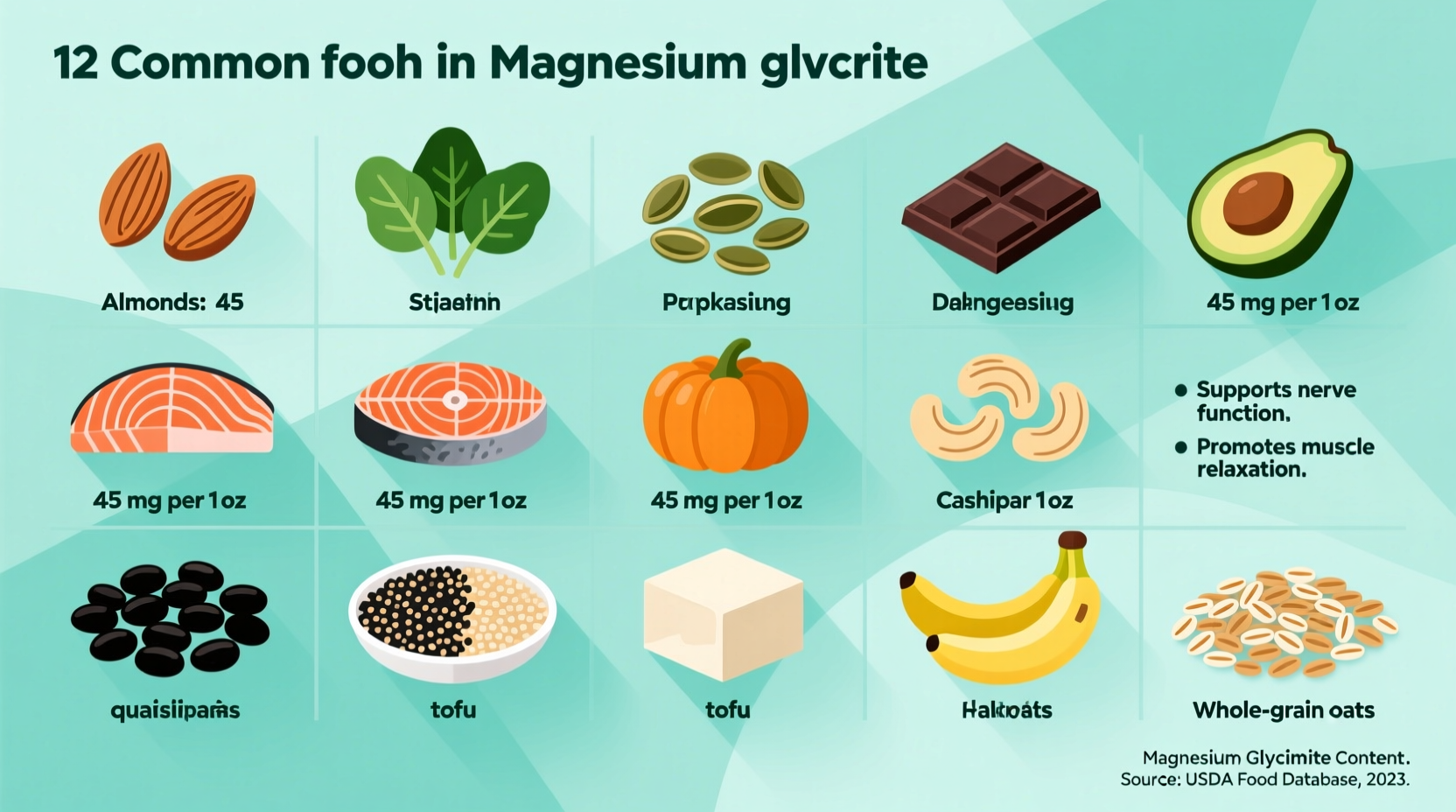Understanding Magnesium Forms: Why Foods Don't Contain Glycinate
When you search for foods with magnesium glycinate, you're encountering a common misconception. Magnesium glycinate is a man-made supplement form developed to improve absorption, not a naturally occurring compound in food. Let's clarify this critical distinction:
- Natural magnesium exists in foods as magnesium salts (like magnesium citrate in fruits or magnesium malate in vegetables)
- Magnesium glycinate is created in labs by chelating (binding) elemental magnesium to the amino acid glycine
- No whole food contains magnesium glycinate—your body converts dietary magnesium into usable forms during digestion
"The confusion between supplemental magnesium forms and dietary magnesium is widespread," explains Antonio Rodriguez, culinary science expert. "Foods provide magnesium in various natural compounds, but glycinate specifically is engineered for better gut tolerance in supplements."

Natural Food Sources with Highest Magnesium Bioavailability
While you won't find magnesium glycinate in foods, these whole food sources deliver magnesium in highly absorbable forms. The following table compares magnesium content and absorption rates from authoritative sources:
| Food Source | Magnesium per Serving | Natural Compound Form | Estimated Absorption Rate |
|---|---|---|---|
| Pumpkin seeds (1 oz) | 156 mg (37% DV) | Magnesium phosphate | 30-40% (NIH, 2023) |
| Spinach, cooked (1 cup) | 157 mg (37% DV) | Magnesium malate | 25-35% (USDA FoodData) |
| Almonds (1 oz) | 80 mg (19% DV) | Magnesium citrate | 25-30% (Am J Clin Nutr) |
| Black beans (1/2 cup) | 60 mg (14% DV) | Magnesium sulfate | 20-25% (NIH) |
| Avocado (1 medium) | 58 mg (14% DV) | Magnesium citrate | 25-30% (USDA) |
This comparison comes from the NIH Office of Dietary Supplements and USDA FoodData Central, showing how different food matrices affect magnesium absorption. Notice that foods with naturally occurring organic acids (like citric acid in almonds) generally have better absorption rates than inorganic magnesium salts.
Why Magnesium Glycinate Was Developed (And When You Might Need It)
Magnesium glycinate was created to solve specific problems with other magnesium forms:
- Superior absorption: Glycine binding helps magnesium bypass digestive issues that limit absorption of oxide or sulfate forms
- Gentler on digestion: Unlike magnesium citrate (which can cause diarrhea), glycinate rarely causes GI distress
- Enhanced benefits: Glycine itself promotes relaxation and better sleep quality
According to clinical research published in the Journal of the American College of Nutrition, magnesium glycinate achieves approximately 30-40% absorption—comparable to the best food sources—but with more consistent delivery. However, for most people with healthy digestion, getting magnesium from diverse whole foods provides additional nutrients that work synergistically.
Maximizing Magnesium Absorption From Food
You can significantly improve how much magnesium your body absorbs from foods by understanding these key factors:
Dietary Companions That Boost Absorption
- Vitamin D: Include fatty fish or fortified foods with magnesium-rich meals (NIH confirms vitamin D enhances magnesium utilization)
- Protein: Pair nuts/seeds with protein sources—try almond-crusted salmon for a magnesium-protein power combo
- Organic acids: Add lemon juice to spinach (citric acid increases magnesium solubility by 20-30%)
Common Inhibitors to Avoid
- Excess zinc: More than 50mg zinc daily can reduce magnesium absorption by 25% (Am J Clin Nutr)
- Phytates in processed grains: Choose sourdough bread over standard whole wheat for better mineral availability
- Coffee/tea with meals: Tannins can bind magnesium—wait 1 hour after eating before consuming
When Supplements Might Be Necessary
While food should be your primary magnesium source, certain situations make supplements like magnesium glycinate appropriate:
- Diagnosed deficiency: Blood tests showing serum magnesium below 1.8 mg/dL
- GI conditions: Crohn's, celiac, or chronic diarrhea that impairs absorption
- Medication interactions: Long-term proton pump inhibitor use reduces magnesium absorption by 30-50%
- High-stress lifestyles: Chronic stress depletes magnesium stores faster than normal
"If you're considering supplements, magnesium glycinate is often the best-tolerated option," advises nutrition researchers at Harvard T.H. Chan School of Public Health. "But always prioritize food sources first—they provide co-factors that isolated supplements can't replicate."
Your Action Plan for Optimal Magnesium Intake
Implement these practical strategies to ensure adequate magnesium from food:
- Start your day with magnesium-rich breakfast: Add pumpkin seeds to oatmeal (1/4 cup provides 190mg magnesium)
- Swap snacks to almonds or cashews (1 oz delivers 20% of daily needs)
- Double your greens: Make spinach or Swiss chard the base of 2 daily meals
- Choose whole grains like quinoa or buckwheat over refined options
- Include legumes 3-4 times weekly—black beans and edamame are excellent sources
For most adults, consistently following these steps meets the Recommended Dietary Allowance (RDA) of 400-420mg for men and 310-320mg for women. Track your intake using the MyPlate tracker for the first two weeks to ensure you're hitting targets.
Frequently Asked Questions
Can you get magnesium glycinate from natural food sources?
No, magnesium glycinate does not exist in natural foods. It's a supplemental form created by binding magnesium to glycine in laboratories. Foods contain magnesium in other natural compounds like citrate, malate, or phosphate.
What's the best food source for magnesium absorption?
Pumpkin seeds and spinach offer both high magnesium content and good bioavailability (30-40% absorption). The magnesium malate in spinach and magnesium phosphate in pumpkin seeds are among the most efficiently absorbed natural forms according to USDA FoodData Central.
How can I tell if I'm magnesium deficient?
Early signs include muscle cramps, fatigue, irregular heartbeat, and sleep disturbances. However, blood tests aren't always reliable since only 1% of magnesium is in blood serum. If you experience these symptoms despite eating magnesium-rich foods, consult a healthcare provider for proper assessment.
Does cooking affect magnesium content in foods?
Yes, but not uniformly. Boiling vegetables like spinach can leach magnesium into water (retain cooking water for soups). Steaming preserves more minerals. Roasting nuts actually concentrates magnesium by reducing water content. The NIH reports minimal magnesium loss in most cooking methods compared to other nutrients.











 浙公网安备
33010002000092号
浙公网安备
33010002000092号 浙B2-20120091-4
浙B2-20120091-4